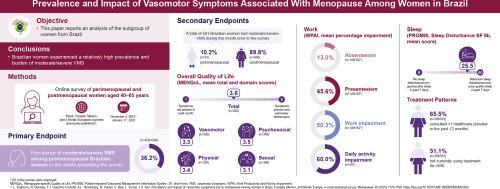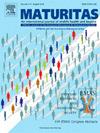Prevalence and impact of vasomotor symptoms associated with menopause among women in Brazil: Subgroup analysis from an international cross-sectional survey
IF 3.9
2区 医学
Q2 GERIATRICS & GERONTOLOGY
引用次数: 0
Abstract
Objective
This study assessed the prevalence and impact of moderate and/or severe vasomotor symptoms and related treatment patterns in midlife women in Brazil.
Study design
Brazilian women aged 40 to 65 years completed an online survey. The prevalence of moderate to severe vasomotor symptoms was assessed in postmenopausal women who completed a series of questionnaires to elicit responses regarding their treatment patterns and attitudes to treatments.
Main outcome measures
Perimenopausal and postmenopausal women with moderate to severe vasomotor symptoms completed three standardized questionnaires (Menopause-Specific Quality of Life questionnaire, Work Productivity and Activity Impairment questionnaire, and the Patient-Reported Outcomes Measurement Information System Sleep Disturbances Short Form 8b) and answered open-ended questions.
Results
Of 1244 postmenopausal women who accessed the survey, 36.2 % had experienced moderate to severe vasomotor symptoms in the previous month. Moderate to severe vasomotor symptoms among 501 perimenopausal and postmenopausal women negatively affected overall quality of life (mean total score on the Menopause-Specific Quality of Life questionnaire was 3.6/8). On the Work Productivity and Activity Impairment questionnaire, women's scores for impairments in overall work and daily activities due to vasomotor symptoms were 50.3 % and 60.0 %, respectively. Overall mean (standard deviation) score on the Patient-Reported Outcomes Measurement Information System Sleep Disturbances Short Form 8b was 25.5 (5.8) on a scale of 8 to 40. Most women sought medical advice (65.5 %), but over half were not receiving treatment. Those who received treatment reported moderately favorable attitudes to hormone and nonhormone prescription medicines, but safety concerns remained.
Conclusion
Brazilian women experienced a relatively high prevalence and burden of moderate to severe vasomotor symptoms.

巴西妇女与更年期相关的血管运动症状的发生率和影响:一项国际横断面调查的分组分析
研究设计40至65岁的巴西妇女完成了一项在线调查。对绝经后妇女中度至重度血管运动症状的患病率进行了评估,并填写了一系列调查问卷,以了解她们对治疗模式和治疗态度的反应。主要结果测量有中度至重度血管运动症状的绝经期和绝经后妇女填写了三份标准化问卷(绝经期生活质量问卷、工作生产率和活动障碍问卷以及患者报告结果测量信息系统睡眠障碍简表8b),并回答了开放式问题。结果在1244名参与调查的绝经后妇女中,36.2%的人在上个月有中度至重度血管运动症状。501名围绝经期和绝经后妇女的中度至重度血管运动症状对整体生活质量产生了负面影响(绝经期生活质量问卷的平均总分为3.6/8)。在 "工作效率和活动障碍 "问卷中,妇女因血管运动症状而导致的整体工作和日常活动障碍得分分别为 50.3% 和 60.0%。患者报告结果测量信息系统睡眠障碍简表 8b 的总平均分(标准差)为 25.5(5.8)分(8-40 分)。大多数妇女寻求医疗建议(65.5%),但超过一半的妇女没有接受治疗。接受治疗的妇女对激素和非激素处方药的态度一般,但对其安全性仍存在担忧。
本文章由计算机程序翻译,如有差异,请以英文原文为准。
求助全文
约1分钟内获得全文
求助全文
来源期刊

Maturitas
医学-妇产科学
CiteScore
9.10
自引率
2.00%
发文量
142
审稿时长
40 days
期刊介绍:
Maturitas is an international multidisciplinary peer reviewed scientific journal of midlife health and beyond publishing original research, reviews, consensus statements and guidelines, and mini-reviews. The journal provides a forum for all aspects of postreproductive health in both genders ranging from basic science to health and social care.
Topic areas include:• Aging• Alternative and Complementary medicines• Arthritis and Bone Health• Cancer• Cardiovascular Health• Cognitive and Physical Functioning• Epidemiology, health and social care• Gynecology/ Reproductive Endocrinology• Nutrition/ Obesity Diabetes/ Metabolic Syndrome• Menopause, Ovarian Aging• Mental Health• Pharmacology• Sexuality• Quality of Life
 求助内容:
求助内容: 应助结果提醒方式:
应助结果提醒方式:


